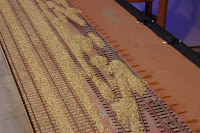Some forward planning of turnout and signalling rodding was needed so I knew where the rodding would be placed. I cut up some 40 x 40 Thou styrene strips and supaglued them down. On the plan you can see the signal cabin is central to the yard so all radiating rodding will terminate at the cabin. Only bthe main lines are controlled by the cabin and all other turnouts controlled by ground levers. The signals in the main station platforms would be cabin operated and the home signal near the ash pits would be as well.

 Ballast....well no special process here other than a good way to settle the grains of stone around the sleepers is to tap the rails with the handle of your brush. This action will bounce the grains off the top of the sleepers and "tamp" them between the sleepers.
Ballast....well no special process here other than a good way to settle the grains of stone around the sleepers is to tap the rails with the handle of your brush. This action will bounce the grains off the top of the sleepers and "tamp" them between the sleepers. 
 The styrene strip is used between the baseboard joins to stop the ballast glue sticking them together and makes for a nice separation of the ballast without it cracking and chipping away.
The styrene strip is used between the baseboard joins to stop the ballast glue sticking them together and makes for a nice separation of the ballast without it cracking and chipping away.Aquadhere doesn't stick to styrene well at all, so it’s put to good use here. Ballasting is completed......
With all the track ballasted glued and dry, the build-up of ballast around the running shed tracks needed some attention clearing the flange-ways before painting the ballast. Then the entire track on the layout was then weathered. The concrete areas at the running shed were covered to avoid paint landing on them. The area was air brushed with matt black, then oversprayed with a light brown and grey mixture.
As stark as this looks, it will blend in with weeds and infrastructure added. Put a few locos on it and the potential for mimicking the prototype increases. There is darkening of track needed in other areas where locos will sit for periods of time, such as at the ends of platforms, and the tracks used more than others need to be dirtier. The two outside tracks of the station platforms were left "cleaner" as they will be covered with weeds. Below are a few locomotives placed just to see how the weathering colours look. With added details and weeds around the area, the dirty looking area around the engine shed will blend right in!






No comments:
Post a Comment